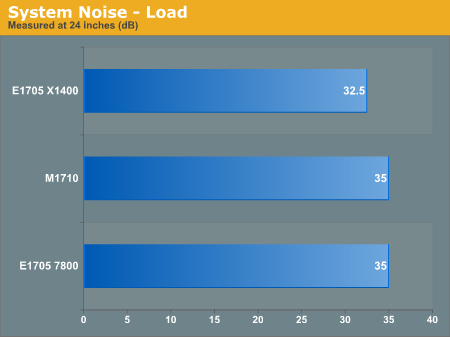Dell DTR Laptop Shootout - M1710 vs. E1705
by Jarred Walton on May 30, 2006 1:30 PM EST- Posted in
- Laptops
Noise and Heat
If you've been wondering why we even bothered to include the X1400 configuration in this article - since it's completely outclassed by either of its big brothers - we're finally getting to some benchmarks where it can turn the tables. We'll start with the more mundane noise levels and temperatures before we get to power draw. In order to provide full load situations, we ran two instances of Folding@Home on the CPU and looped 3DMark05 in the foreground.Noise

Despite having substantially different graphics processors, the noise levels on all three systems are pretty comparable. The two GeForce configurations get slightly louder at full load, but when idling all three computers drop below 30 dB. (We didn't bother to create a graph showing all three at <30 dB when idle.) Our SPL meter can't reliably measure anything below 30 dB, so we essentially have to declare a tie. The slight noise of the hard drive can be clearly heard over anything else, and if you allow the hard drive to power off when it's not in use the systems become about as silent as possible. Of course, the instant you actually do any work, the hard drive has to spin back up, but only extended use of CPU or GPU intensive applications will raise the noise level above 30 dB.
Heat
We measured temperatures across the bottom of the system as well as on the keyboard and palm rests. Graphs don't do a good job of conveying this information, so we've used a table instead. We broke down the temperatures into five primary areas: left-hand, right hand, left leg, right leg, and bottom center. The bottom center area of the laptop houses the memory, and while this area would generally not be touching your legs with the system sitting on your lap, it did generate enough heat that we felt this hotspot needed to be pointed out.
| Laptop Temperatures (°C) | ||||||
| M1710 Load | M1710 Idle | 7800 Load | 7800 Idle | X1400 Load | X1400 Idle | |
| Bottom Left | 32-38 | 30-37 | 32-38 | 30-37 | 28-37 | 29-34 |
| Bottom Right | 40-44 | 39-42 | 37-41 | 39-42 | 31-35 | 34-38 |
| Bottom Center | 47-48 | 39-40 | 40-41 | 39-40 | 38-39 | 35-36 |
| Top Left | 32-35 | 31-34 | 30-33 | 31-34 | 27-31 | 27-31 |
| Top Right | 36-41 | 35-38 | 35-39 | 35-38 | 27-31 | 30-35 |
One of the interesting items that you almost immediately notice is that the temperatures under idle conditions aren't substantially cooler than temperatures under load conditions. The reason is quite simple: unless the CPU and/or GPU are generating a lot of heat, most of the fans are shut off. We never experienced any heat related crashes during our testing, and the temperatures are all low enough that we don't expect problems for most people. All testing was conducted in a 22°C environment; however, in a hotter climate the M1710 could potentially get too hot.
A temperature of 40+ °C might be considered uncomfortably warm for many people, especially if the laptop is resting directly against the skin. If you were outside on a warm summer day, surface temperatures would almost certainly be hotter than you would want in your lap. We didn't find it to be too bad while wearing jeans in more moderate conditions, but these systems are definitely more at home sitting on a table rather than your lap, which is typical of desktop replacement notebooks.










34 Comments
View All Comments
Gary Key - Tuesday, May 30, 2006 - link
Jarred will be reviewing these in the near future.tthiel - Tuesday, May 30, 2006 - link
I've been issued plenty of Dell laptops at the various companies I have worked for and they were all cheap plasticky junk. I've lost track of how many died on me. I was just given a new Thinkpad T43P and it is much better. Very well made, rock solid. So many of the engineers where I work wanted those instead of Dells that they had to restructure the ordering process and images to take care of all the new Thinkpads.JarredWalton - Tuesday, May 30, 2006 - link
I've heard about problems with ThinkPads now that Lenovo has taken over. (I haven't used any personally, so I can't say for sure.) I have also used many of the older Inspiron models, and have been unimpressed. These are definitely in a different league, however -- the cheap plastic case (at least on top) has been replaced by aluminum, for example. The problem is that most businesses don't buy higher end Dell laptops; they go with the more value oriented offerings, and whenever prices cut you can be sure that quality is cut as well.We're hoping to expand our mobile coverage in the future, so this is merely the beginning. As time goes on, we'll have more products that we can directly compare new offerings with. For now, I'm generally impressed with what the E1705 offers. Impressed enough that I recommended one to a family member, after browsing around looking for a suitable equivalent. Getting a large laptop with a 17 inch (or larger) display, 1920x1200 resolution, dual core processor, etc. is pretty difficult right now. Getting one with 2 GB of RAM for $2300 is even more difficult. Not everyone wants a laptop this large, certainly, but for those that do the E1705 is quite good.
jenson - Monday, January 7, 2013 - link
when cheap laptops really got a good shake, with many models looking and behaving a lot more like their costly cousins than in the past.